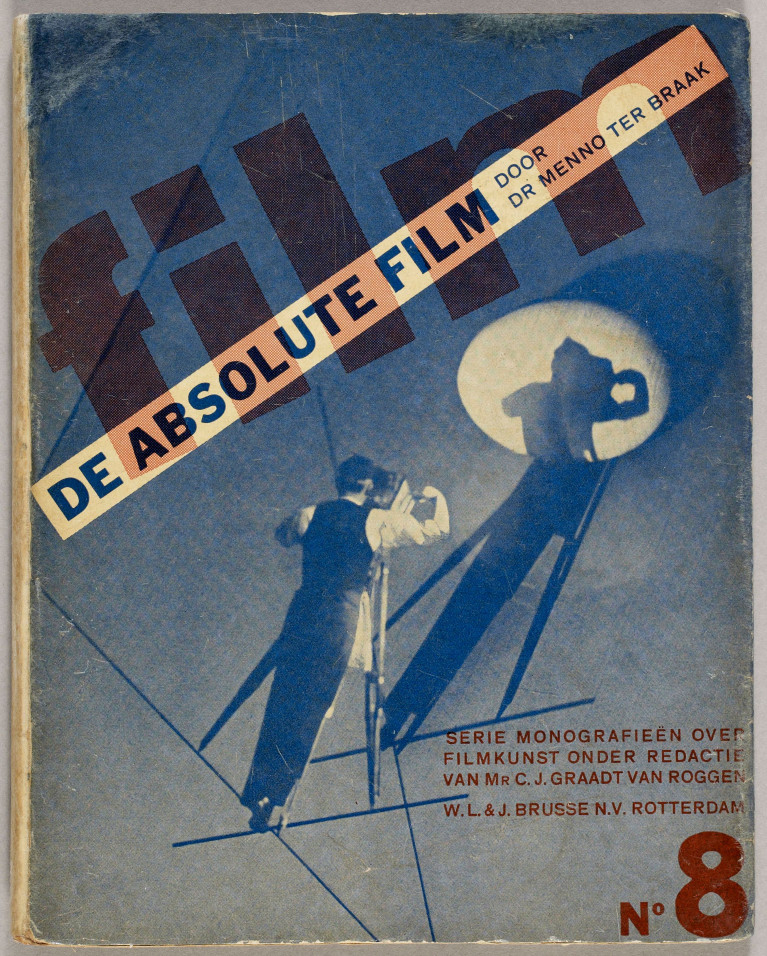Series of Monographs on Cinema, 10 vols. (1931–33) [NL]
Filed under book | Tags: · abstract cinema, avant-garde, cinema, experimental film, film, film history, film sound, film theory, graphic design, montage, silent cinema


This set of monographs on early twentieth-century film is as important for the discourses on cinema, as it is for the graphic design.
Each volume has a cover created by the Dutch “typotekt” Piet Zwart, who had multiple careers as an interior designer, industrial design, commercial typographer, photographer, critic and lecturer. At the close of the twentieth century, Zwart was named ‘Designer of the Century’ by the Association of Dutch Designers.
Originally planned in twelve volumes, the last two in the series were not published: De techniek van de kunstfilm by M.T.H. Franken and Joris Ivens and Filmreclame by Piet Zwart.
Film: die serie monografieën over filmkunst
Series edited by C.J. Graadt van Roggen
Cover design Piet Zwart
Publisher W.L. & J. Brusse’s Uitgeversmaatschappij, Rotterdam, 1931-33
via Bibliothèque Kandinsky
Wikipedia (NL)
1 Het linnen venster, by C.J. Graadt van Roggen (1931, 72 pp, 71 MB)
2 Dertig jaar film [Thirty Years of Film], by L.J. Jordan (1932, 79 pp, 73 MB)
3 Nederlandsche filmkunst, by Henrik Scholte (1933, 64 pp, 63 MB)
4 Russische filmkunst, by Th. B.F. Hoyer (1932, 84 pp, 85 MB)
5 Duitsche filmkunst [German Cinema], by Simon Koster (1931, 75 pp, 71 MB)
6 Fransche filmkunst, by Elisabeth de Roos (1931, 59 pp, 61 MB)
7 Amerikaansche filmkunst, by Jo Otten (1931, 70 pp, 71 MB)
8 De absolute film, by Menno ter Braak (1931, 50 pp, 50 MB), HTML (at DBNL)
9 De komische film, by Constant van Wessem (1931, 56 pp, 49 MB)
10 De geluidsfilm [Sound Film], by Lou Lichtveld (1933, 79 pp, 76 MB), HTML (at DBNL)
Eccentric Manifesto (1922/1992)
Filed under manifesto, pamphlet | Tags: · art, avant-garde, cinema, film, manifesto, theatre

“The ‘Depot of Eccentrics’ which on the 9th July 1922 published The Eccentric Manifesto–a pamphlet ‘the size of an ordinary letter’–proved an ephemeral collaboration. In the words of subsequent critics, ‘difference of opinion’, ‘stern criticism’ caused its dissolution soon after The Factory of Eccentric Actor’s first productions–a stage version of Gogol’s The Wedding (1922) and a Cocteau inspired piece in three acts, Foreign Trade on the Eiffel Tower (1923).
A great rarity, the manifesto itself does not seem to have been any more influential than the ‘depot’ which published it. Containing four articles–by Leonid Trauberg, Grigori Kozintsev, Sergei Yutkevich and professional gambler Georgii Kryzhitskii–its post-civil war Petrograd print issue was limited to 1000 copies. Of these ‘a majority’ were entrusted by Yutkevich to Pravda critic Khrisanf Khersonsky to spread around Moscow ‘using his contacts’. Sales went badly however and the whole stock was dumped in Khersonsky’s basement where, when the house caught fire, it was ‘completely destroyed.’
[…] Kozintsev and Trauberg later made the film New Babylon (1929), subtitled “Assault on the Heavens–episodes from the Franco Prussian War and the Paris Commune 1870-71”, based less on Karl Marx than on the history of the Paris Commune written by P.O. Lissagaray. [The screenings were accompanied with an ensemble playing a score by Dmitri Shostakovich]. … In later years Shostakovich was to claim that ‘my troubles on the political front began with New Babylon.'” (from the Introduction)
First published in Russian in St Petersburg, 1922
Translated and with an Introduction by Marek Pytel
Cover by Clifford Harper
Publisher Eccentric Press, London, 1992
22 pages
via Reality
Entry on Factory of Eccentricity in Saint Petersburg Encyclopedia (in English)
PDF (lo-res), GIF images
Title page of Russian edition
Julia Vaingurt: Wonderlands of the Avant-Garde: Technology and the Arts in Russia of the 1920s (2013)
Filed under book | Tags: · 1920s, aesthetics, architecture, art, art history, avant-garde, biomechanics, body, cinema, communism, constructivism, design, literature, machine, politics, russia, science fiction, sexuality, socialism, soviet union, technē, technology, theatre

“In postrevolutionary Russia, as the Soviet government was initiating a program of rapid industrialization, avant-garde artists declared their intent to serve the nascent state and to transform life in accordance with their aesthetic designs. In spite of their professed utilitarianism, however, most avant-gardists created works that can hardly be regarded as practical instruments of societal transformation. Exploring this paradox, Vaingurt claims that the artists’ investment of technology with aesthetics prevented their creations from being fully conscripted into the arsenal of political hegemony. The purposes of avant-garde technologies, she contends, are contemplative rather than constructive. Looking at Meyerhold’s theater, Tatlin’s and Khlebnikov’s architectural designs, Mayakovsky’s writings, and other works from the period, Vaingurt offers an innovative reading of an exceptionally complex moment in the formation of Soviet culture.”
Publisher Northwestern University Press, 2013
SRLT series
ISBN 0810128942, 9780810128941
322 pages
via Sorin
Review: Boris Dralyuk (NEP, 2013), Tim Harte (Slavic Review, 2014).
PDF (updated on 2022-11-12)
See also the science-fiction film Aelita, Queen of Mars, dir. Yakov Protazanov, 1924, 111 min, based on Tolstoy’s novel.
Comments (2)
